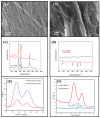Probe Sensor Using Nanostructured Multi-Walled Carbon Nanotube Yarn for Selective and Sensitive Detection of Dopamine
- PMID: 28420196
- PMCID: PMC5424761
- DOI: 10.3390/s17040884
Probe Sensor Using Nanostructured Multi-Walled Carbon Nanotube Yarn for Selective and Sensitive Detection of Dopamine
Abstract
The demands for electrochemical sensor materials with high strength and durability in physiological conditions continue to grow and novel approaches are being enabled by the advent of new electromaterials and novel fabrication technologies. Herein, we demonstrate a probe-style electrochemical sensor using highly flexible and conductive multi-walled carbon nanotubes (MWNT) yarns. The MWNT yarn-based sensors can be fabricated onto micro Pt-wire with a controlled diameter varying from 100 to 300 µm, and then further modified with Nafion via a dip-coating approach. The fabricated micro-sized sensors were characterized by electron microscopy, Raman, FTIR, electrical, and electrochemical measurements. For the first time, the MWNT/Nafion yarn-based probe sensors have been assembled and assessed for high-performance dopamine sensing, showing a significant improvement in both sensitivity and selectivity in dopamine detection in presence of ascorbic acid and uric acid. It offers the potential to be further developed as implantable probe sensors.
Keywords: Nafion coating; dopamine detection; multi-walled carbon nanotubes; nano yarn; probe sensor.
Conflict of interest statement
The authors declare no conflict of interest.
Figures




Similar articles
-
Unmodified and multi-walled carbon nanotube modified tetrahedral amorphous carbon (ta-C) films as in vivo sensor materials for sensitive and selective detection of dopamine.Biosens Bioelectron. 2018 Oct 30;118:23-30. doi: 10.1016/j.bios.2018.07.018. Epub 2018 Jul 11. Biosens Bioelectron. 2018. PMID: 30055416
-
Electrochemical detection of nanomolar dopamine in the presence of neurophysiological concentration of ascorbic acid and uric acid using charge-coated carbon nanotubes via facile and green preparation.Talanta. 2016 Jan 15;147:453-9. doi: 10.1016/j.talanta.2015.10.020. Epub 2015 Oct 8. Talanta. 2016. PMID: 26592632
-
Evaluation of carbon nanotube fiber microelectrodes for neurotransmitter detection: Correlation of electrochemical performance and surface properties.Anal Chim Acta. 2017 May 1;965:1-8. doi: 10.1016/j.aca.2017.01.039. Epub 2017 Jan 31. Anal Chim Acta. 2017. PMID: 28366206 Free PMC article.
-
A Nonoxidative Electrochemical Sensor Based on a Self-Doped Polyaniline/Carbon Nanotube Composite for Sensitive and Selective Detection of the Neurotransmitter Dopamine: A Review.Sensors (Basel). 2008 Dec 18;8(12):8423-8452. doi: 10.3390/s8128423. Sensors (Basel). 2008. PMID: 27873994 Free PMC article. Review.
-
Single walled carbon nanotubes as reporters for the optical detection of glucose.J Diabetes Sci Technol. 2009 Mar 1;3(2):242-52. doi: 10.1177/193229680900300204. J Diabetes Sci Technol. 2009. PMID: 20144355 Free PMC article. Review.
Cited by
-
Smartphone-Based Electrochemical Potentiostat Detection System Using PEDOT: PSS/Chitosan/Graphene Modified Screen-Printed Electrodes for Dopamine Detection.Sensors (Basel). 2020 May 14;20(10):2781. doi: 10.3390/s20102781. Sensors (Basel). 2020. PMID: 32422926 Free PMC article.
-
Hybrid Graphene/Conducting Polymer Strip Sensors for Sensitive and Selective Electrochemical Detection of Serotonin.ACS Omega. 2019 Dec 16;4(26):22169-22177. doi: 10.1021/acsomega.9b03456. eCollection 2019 Dec 24. ACS Omega. 2019. PMID: 31891099 Free PMC article.
-
Flexible sensor with electrophoretic polymerized graphene oxide/PEDOT:PSS composite for voltammetric determination of dopamine concentration.Sci Rep. 2021 Oct 26;11(1):21101. doi: 10.1038/s41598-021-00712-w. Sci Rep. 2021. PMID: 34702959 Free PMC article.
References
-
- Fayemi O.E., Adekunle A.S., Ebenso E.E. Metal Oxides Nanoparticles/ Multi-walled Carbon Nanotube Nanocomposite Modified Electrode for the Detection of Dopamine: Comparative Electrochemical Study. J. Biosens. Bioelectron. 2015;6:190. doi: 10.4172/2155-6210.1000190. - DOI
-
- Wu K., Hu S. Electrochemical Study and Selective Determination of Dopamine at a Multi-Wall Carbon Nanotube-Nafion Film Coated Glassy Carbon Electrode. Microchim. Acta. 2004;144:131–137. doi: 10.1007/s00604-003-0103-4. - DOI
MeSH terms
Substances
LinkOut - more resources
Full Text Sources
Other Literature Sources

